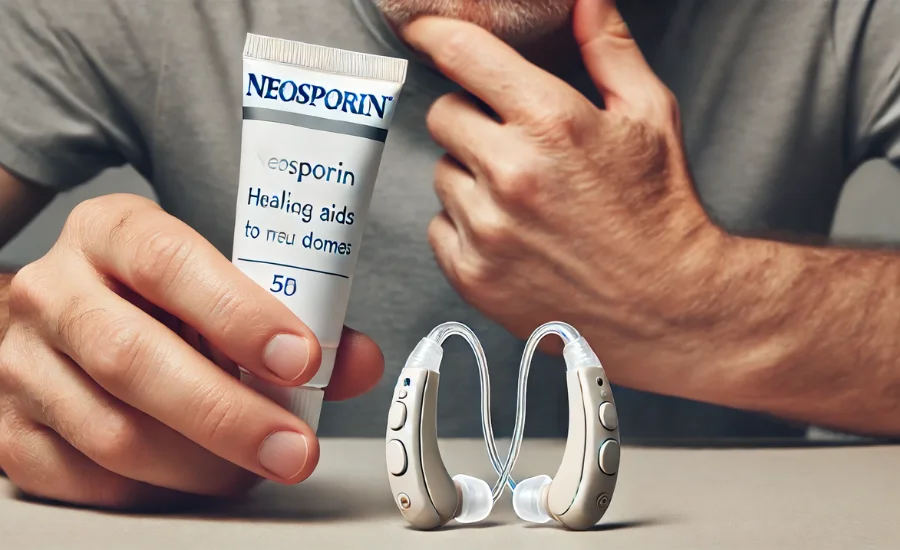Can i use neosporin in my hearing aid domes: Experiencing irritation or discomfort in your ears can be quite unsettling. Many individuals wonder whether Neosporin, a staple in most first aid kits, is suitable for use in hearing aid domes. While it’s tempting to turn to familiar solutions for relief, it’s important to consider whether this approach is truly appropriate for your ear health.
Before applying any over-the-counter ointments, including Neosporin, it’s wise to consult with a healthcare professional. They can provide tailored advice based on your specific situation and help you find the most effective and safe treatment for ear discomfort.
What Are Hearing Aid Domes?
Hearing aid domes are small, flexible attachments made from silicone or rubber that fit onto the receiver end of a hearing aid. They are designed to sit inside the ear canal and deliver sound directly into the ear. These domes are a critical part of modern hearing aids, particularly those in behind-the-ear (BTE) or receiver-in-canal (RIC) models, enhancing both sound quality and user comfort.
Functions of Hearing Aid Domes
- Enhancing Sound Clarity: Hearing aid domes improve sound delivery by funneling sound directly into the ear canal, reducing distortions and background noise. This ensures that wearers experience clearer speech and environmental sounds. A properly fitted dome enhances this sound clarity by minimizing the chance of feedback, which can cause high-pitched whistling sounds due to sound leakage.
- Comfort for Extended Use: Due to their soft material and variety of sizes, hearing aid domes are designed to provide maximum comfort, even during extended periods of wear. Ensuring the right fit is crucial for both comfort and preventing any irritation or discomfort, especially when used for several hours a day.
- Reducing Feedback and Whistling: Feedback occurs when sound escapes from the ear canal and re-enters the microphone, resulting in a whistling noise. Well-fitting domes help create a better seal within the ear canal, reducing sound leakage and minimizing the likelihood of feedback. This feature ensures a smoother, more pleasant hearing experience.
- Tailoring the Hearing Experience: Different types of domes offer varying levels of sound amplification and control. For instance, open domes allow more natural sound to pass through, while closed or power domes block external noise and provide stronger sound amplification. This customization ensures that hearing aids meet the specific needs of each user’s hearing loss profile.
Types of Hearing Aid Domes
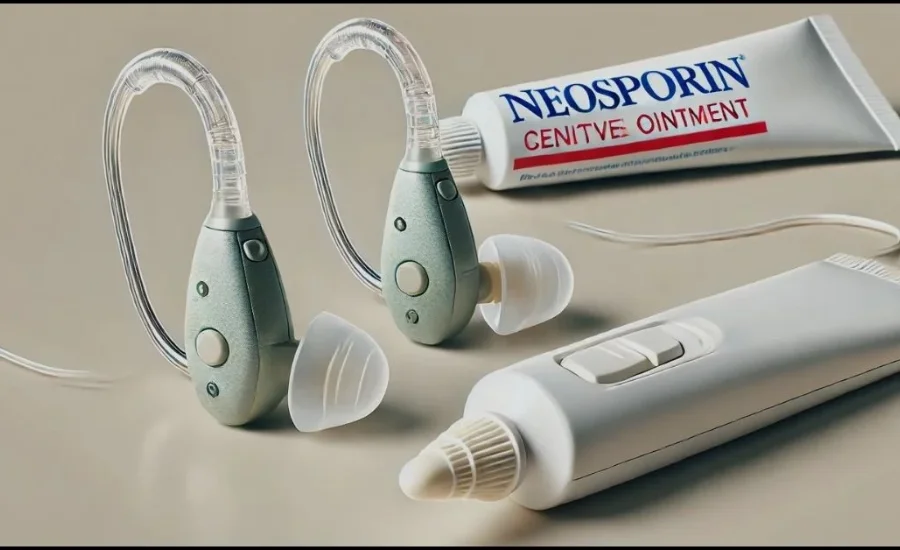
Hearing aid domes come in several types, each catering to specific hearing needs and levels of comfort. Choosing the right type of dome is essential to maximizing the performance of your hearing aid.
- Open Domes: Open domes have small ventilation holes that allow natural sounds to enter the ear along with amplified sound. This creates a more balanced and natural listening experience, ideal for individuals with mild to moderate hearing loss. Open domes prevent the “plugged-up” feeling some hearing aid users experience, and they are great for those who want to retain some ambient sound awareness.
- Closed Domes (Vented Domes): Closed domes, also known as vented domes, have fewer or smaller ventilation holes, providing greater sound amplification by reducing the amount of natural sound that can enter the ear. These are ideal for individuals with moderate to severe hearing loss who need more amplification without interference from outside noise.
- Power Domes (Double Domes): Power domes, also called double domes, offer the most amplification by creating a strong seal in the ear canal. They are designed for those with severe hearing loss and are effective in blocking external noise and preventing feedback. However, they may cause some users to experience a more occluded feeling in their ear due to the lack of ventilation.
- Custom Domes: Some hearing aid users require custom domes, which are molded to fit the unique shape of their ear canal. These offer the best combination of comfort and sound quality for individuals who cannot achieve a proper fit with standard domes or who have sensitive skin that is prone to irritation.
Choosing the Right Dome
Selecting the right dome is crucial for comfort, sound clarity, and overall performance of your hearing aids. Several factors play a role in this decision:
- Level of Hearing Loss: Mild hearing loss may only require an open dome, while moderate to severe hearing loss often necessitates closed or power domes for enhanced amplification.
- Comfort: A dome that fits securely yet comfortably in the ear canal is essential. If a dome is too small or too large, it can cause discomfort, irritation, or even block sound.
- Sound Quality: The type of dome directly impacts sound quality. Open domes allow more natural sound but can limit amplification, while closed or power domes offer better amplification by blocking external noise.
- Feedback Issues: If feedback is a persistent issue, a closed or power dome can help create a tighter seal in the ear canal, reducing the chances of sound leaking out.
Maintenance and Care for Hearing Aid Domes
Keeping your hearing aid domes clean and in good condition is essential to ensure proper functionality and prevent any health issues such as infections. Over time, earwax and debris can accumulate in the domes, affecting sound quality and potentially causing discomfort.
- Cleaning the Domes Regularly: To maintain sound clarity and hygiene, clean your hearing aid domes regularly. Use a soft, dry cloth or a specialized hearing aid cleaning tool to remove earwax and dirt. Avoid using water or cleaning solutions unless specifically advised by your audiologist, as moisture can damage the electronic components of the hearing aid.
- Replacing Domes: Hearing aid domes need to be replaced periodically, usually every two to three months or as recommended by your hearing care provider. Domes can wear out, become discolored, or lose their shape over time, which can affect their performance and fit.
- Inspecting for Damage: Regularly check your domes for cracks, discoloration, or stiffness. Damaged domes can lead to discomfort and poor sound quality. If a dome appears worn out or damaged, it’s important to replace it to avoid feedback and irritation.
- Avoiding Moisture Exposure: Moisture can damage both the domes and the hearing aid itself. It’s also advisable to store your hearing aids in a dry, moisture-free environment or use a hearing aid dehumidifier to remove any residual moisture.
Can I Use Neosporin in My Hearing Aid Domes?
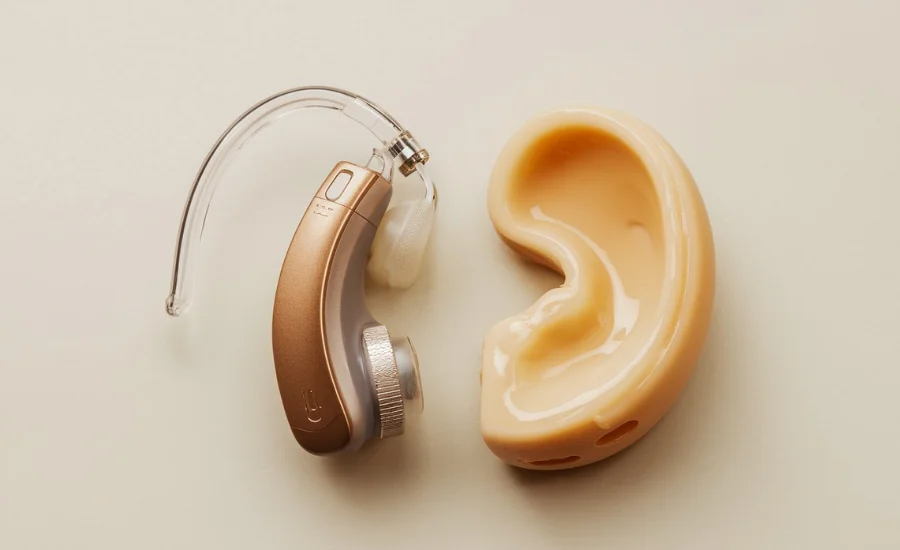
Applying Neosporin inside your ear canal could block sound transmission, leading to diminished hearing aid performance. Additionally, the ointment may accumulate in the hearing aid dome, potentially causing damage or clogging the tiny sound channels. If you’re experiencing ear irritation due to your hearing aid domes, it’s best to consult with a healthcare professional or audiologist before applying any ointments or medications. They can provide safe alternatives and suggest solutions that won’t compromise your hearing aids’ functionality.
Common Issues with Hearing Aid Domes
Despite the many benefits of hearing aid domes, some users may experience problems, especially if the domes are not properly fitted or maintained.
- Ear Irritation or Discomfort
Prolonged use of ill-fitting hearing aid domes can cause irritation or soreness in the ear canal. This can also happen if earwax builds up or if the material of the dome causes an allergic reaction. If you experience discomfort, switching to a different dome size or material, or opting for custom domes, may help. - Wax and Moisture Buildup
Domes can sometimes trap earwax and moisture inside the ear canal, which can lead to blockages, infections, or reduced sound clarity. Cleaning the domes regularly and using a hearing aid dehumidifier can help reduce these issues. - Sound Blockage
Earwax or debris can block the sound output from the hearing aid, reducing its effectiveness. Regular cleaning and ensuring the domes are free from obstructions will help maintain optimal sound quality. - Dome Displacement
Domes that do not fit properly can move inside the ear canal, which can lead to discomfort, sound distortion, or feedback. In rare cases, a dome may become lodged in the ear, requiring professional removal. Ensuring a secure fit by using the correct size and regularly checking for wear can help prevent this.
When to Seek Professional Advice
If you’re experiencing ongoing discomfort, hearing aid malfunctions, or if you’re unsure about whether a specific treatment like using Neosporin is safe for your ears, it’s important to seek advice from an audiologist. They can evaluate your hearing aid domes’ fit and recommend changes or alternatives to address any irritation or discomfort.
Alternatives to Neosporin for Ear Care
Instead of reaching for Neosporin, individuals experiencing ear discomfort should seek alternatives specifically designed for ear health. Consulting with an audiologist is crucial; they can recommend ear-friendly products that won’t interfere with hearing aid function. Options include antibacterial ear drops formulated for safe use, as well as cleaning solutions designed to maintain ear hygiene without the risks associated with ointments. Additionally, regular cleaning of hearing aid domes can prevent buildup of wax and moisture, which are common causes of irritation.
When it comes to managing ear health, understanding the nature of hearing aid domes is essential. These small attachments play a vital role in delivering sound effectively and ensuring comfort. Therefore, safeguarding their functionality should be a top priority.
By prioritizing proper ear care and choosing suitable products, users can maintain both their ear health and the performance of their hearing aids without resorting to inappropriate treatments like Neosporin.
Why You Should Avoid Using Neosporin in Hearing Aid Domes
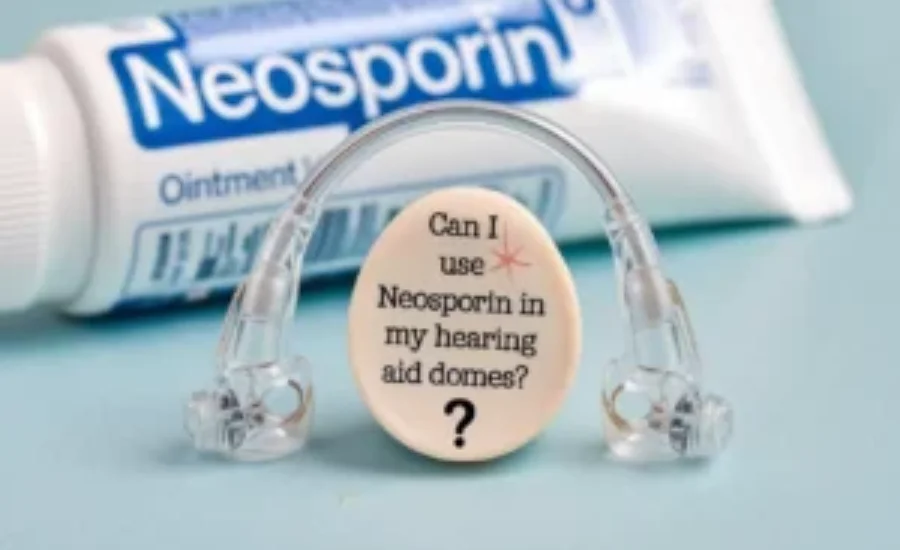
When ear discomfort or irritation arises, it’s common to reach for the nearest available remedy, like Neosporin. This over-the-counter ointment is widely recognized for its effectiveness in treating minor cuts, scrapes, and skin irritations. However, when it comes to using Neosporin in hearing aid domes, things aren’t so straightforward. While it might seem like an easy fix, applying Neosporin to hearing aid domes can cause more harm than good. Let’s explore why this isn’t a good idea and what alternatives are available to address ear irritation safely.
Understanding the Role of Hearing Aid Domes
Before delving into why Neosporin isn’t suitable for hearing aid domes, it’s essential to understand what these domes are and their role in hearing aid performance. Hearing aid domes are small, soft silicone or rubber attachments that fit over the end of the hearing aid’s receiver, which is the part that sits inside the ear canal. Their primary function is to deliver sound more effectively by providing a snug fit in the ear. Domes also prevent feedback, improve sound clarity, and ensure the user experiences maximum comfort while wearing the device.
Because hearing aid domes come into direct contact with the ear canal, they are prone to issues such as moisture buildup, wax accumulation, and potential irritation. These problems might prompt users to consider applying topical ointments like Neosporin to alleviate discomfort. However, this approach is not recommended.
The Risks of Using Neosporin in Hearing Aid Domes
Can i use neosporin in my hearing aid domes introduce several complications, ranging from device malfunction to worsening ear conditions. Here’s a closer look at why this common antibiotic ointment isn’t the right choice for hearing aid users.
Device Damage
Hearing aids are delicate, finely-tuned devices designed to amplify sound while maintaining clarity. Neosporin, being an ointment, has a thick, greasy texture that can easily clog the domes and interfere with sound transmission. If the ointment seeps into the internal components of the hearing aid, it can cause blockages that lead to sound distortion or even complete malfunction. Since hearing aids are a significant investment, any damage caused by foreign substances like Neosporin could result in costly repairs or replacements.
Additionally, hearing aids are sensitive to moisture and oil-based substances. The greasy residue left by Neosporin can disrupt the internal electronics of the device, leading to long-term damage. Given the complexity of hearing aid technology, it’s best to avoid applying anything that isn’t specifically formulated for hearing aids.
Ear Canal Blockage
Hearing aids are designed to channel sound directly into the ear canal, but applying Neosporin to the domes can create unintended blockages. The ointment’s thick consistency can trap earwax, dirt, and bacteria in the ear canal, exacerbating irritation or even leading to infections. Moreover, Neosporin can interfere with the natural earwax removal process, potentially causing wax buildup. This could result in discomfort, reduced hearing, and the need for professional cleaning of both the ear and the hearing aid domes.
Allergic Reactions
While Neosporin is generally safe for use on minor cuts and scrapes, applying it inside the ear canal poses a risk of allergic reactions. Some people may be allergic to ingredients in Neosporin, such as neomycin. When applied inside the ear, these allergens can cause swelling, itching, or even more severe infections. Since the ear canal is a sensitive area, allergic reactions can lead to significant discomfort and may require medical attention to resolve.
Moisture Buildup
One of the most critical concerns with using Neosporin in hearing aid domes is moisture buildup. Hearing aids are highly sensitive to moisture, which can damage their internal components. By introducing an oily substance like Neosporin, users increase the likelihood of moisture accumulation, which can create the perfect environment for bacteria and fungi to thrive. This can lead to conditions like swimmer’s ear (otitis externa) or other bacterial infections, further complicating ear health and requiring additional medical intervention.
Safe Alternatives to Neosporin for Ear Irritation
If you’re dealing with ear irritation while using hearing aids, it’s crucial to use treatments that are both safe and effective. Instead of using Neosporin, there are several alternatives that won’t interfere with your hearing aids’ functionality or exacerbate ear problems.
Consult an Audiologist
Before attempting any treatment for ear irritation, consult with an audiologist or an ENT (Ear, Nose, and Throat) specialist. These professionals can diagnose the root cause of the discomfort, whether it’s an infection, wax buildup, or an ill-fitting hearing aid dome. They will provide personalized recommendations and ensure that the treatment doesn’t harm your hearing aids.
Use Antibacterial Ear Drops
If you suspect an ear infection, use antibacterial ear drops formulated specifically for the ear canal. These drops can treat bacterial infections without risking damage to your hearing aids. Always check with your healthcare provider before using ear drops to ensure they are suitable for your condition.
Try Ear Cleaning Solutions
Over-the-counter ear cleaning solutions can help remove wax buildup and prevent minor irritations without introducing thick ointments like Neosporin into the ear canal. These solutions are safe for use with hearing aids and won’t leave behind any residue that could damage the devices.
Moisture Control Products
If moisture buildup is causing discomfort, consider using a dehumidifier or drying kit designed for hearing aids. These products help keep both your ears and hearing aids dry, reducing the risk of moisture-related problems.
Adjust Your Hearing Aid Domes
Sometimes ear irritation stems from an improper fit rather than an infection or wax buildup. If the domes are too large or too small, they can cause discomfort. Speak to your audiologist about getting properly fitted hearing aid domes to ensure both comfort and optimal performance.
Proper Care for Hearing Aid Domes
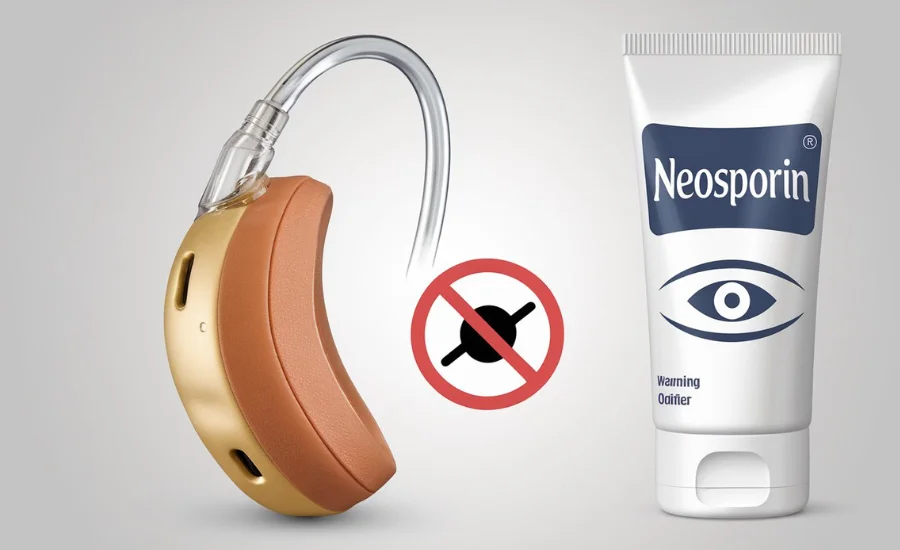
Taking good care of your hearing aid domes can prevent many common issues, such as irritation and infections. Here’s how you can maintain your domes and ensure they remain in good condition:
Regular Cleaning
Clean your hearing aid domes regularly to remove any wax or dirt buildup. Use a soft, dry cloth or a specialized hearing aid cleaning kit to gently wipe down the domes. Avoid using water or harsh cleaning solutions, as moisture can damage the internal components of the hearing aid.
Replace Domes Periodically
Hearing aid domes aren’t meant to last forever. Over time, the material can wear down or become damaged, leading to discomfort or poor sound quality. Check with your audiologist to determine how often you should replace your domes based on your usage and hearing aid model.
Final Words
When experiencing ear discomfort from hearing aids, you might wonder, “Can I use Neosporin in my hearing aid domes?” Applying Neosporin can block sound transmission, damage delicate hearing aid components, and increase the risk of ear infections or allergic reactions. Instead, it’s best to consult with an audiologist for safe solutions to ear irritation. They can suggest alternatives like antibacterial ear drops, proper dome adjustments, or ear-friendly cleaning products that won’t interfere with your hearing aids’ performance.
For expert advice and safe solutions for your hearing aid care, trust Gravity Internetnet—your guide to better hearing health.

